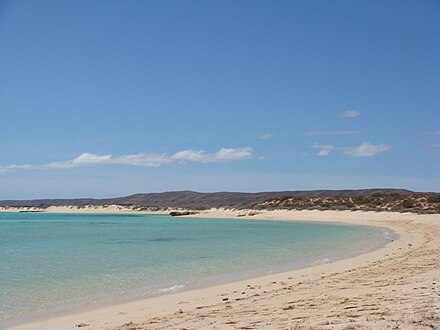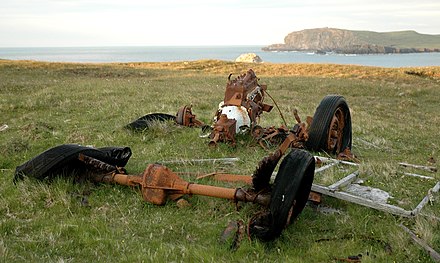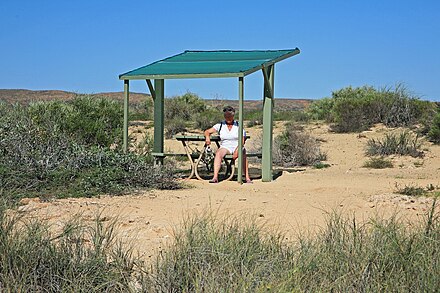Cape Range National Park - national park in Western Australia
Cape Range National Park is in the coastal hills 50 km from Exmouth in the Gascoyne region of Western Australia. It is one of the main ways to access Ningaloo Marine Park.
Understand

 Some 3 to 5 million years ago, this area of Australia lay under a shallow sea, and built up calcareous deposits – billions upon squillions of sea shells. Then it uplifted to form a limestone plateau, which became dissected by canyons, while underground down to the water table became riddled with caves. The high point on the plateau now stands at 314 m / 1030 ft, and the ridge forms a peninsula. Limestone continued to build offshore, creating Ningaloo Reef almost 300 km long. This was a major barrier to European exploration, let alone colonisation, so early arrivals hunted whales offshore but kept clear of the dangerous coast.
Some 3 to 5 million years ago, this area of Australia lay under a shallow sea, and built up calcareous deposits – billions upon squillions of sea shells. Then it uplifted to form a limestone plateau, which became dissected by canyons, while underground down to the water table became riddled with caves. The high point on the plateau now stands at 314 m / 1030 ft, and the ridge forms a peninsula. Limestone continued to build offshore, creating Ningaloo Reef almost 300 km long. This was a major barrier to European exploration, let alone colonisation, so early arrivals hunted whales offshore but kept clear of the dangerous coast.
In the early 19th century Captain Phillip Parker King made a series of explorations around Australia, mapping, cataloguing minerals and wildlife, and repairing the ship after occasional lost battles with the reefs and rocks. In 1818 he named the North West Cape, which had been "Warnangura" to the Aboriginal Yinikutira people. You could just about manoevre a small vessel in at the places now called Maud's Landing and Exmouth, but there were better landings at Dampier further east. Tracts of land were gradually taken for cattle and sheep farming, and land conflict spelt the end of the Yinikutira.
Farming was little joy in this hot arid landscape and in the 1960s the leases were sold back to the government. Cape Range National Park was established in 1964 - referring to the range of hills forming the North West Cape, there isn't a promontory called "Cape Range". In 1987 some 260 km of the reef were designated as Ningaloo Marine Park, with the landward park being one of many places where it's easily accessible from shore.
Wildlife commonly seen on land includes white-bellied sea eagles, rock wallabies, emus, kangaroos and echidnas.
Offshore are turtles, octopus, sting rays, manta rays, whale sharks, tiger sharks and reef sharks. Plus corals, which of course are animals: true vegetation is as sparse underwater here as it is on the baking land.
Deep underground are weird troglodyte creatures that have evolved in the caves in isolation. Their survival depends upon keeping their habitat unsullied, so you'll only see them in displays in the Visitor Centre.
Climate is hot and dry almost all year round - a cool day means 30°C. Nov to April the temperature routinely exceeds 40°C and cyclone downpours are possible. There is no shade in the arid treeless scrub, and no fresh water supply. You need about 5 litres of water per person per day, which of course is heavy, and carrying it raises a thirst.
Get in
The only approach is by the 50 km coast road from Exmouth, which is the nearest place with public transport. Most visitors simply day-trip from there. There's no fuel in the park so think about the getting back.
The boat trips along Yardie Creek have a connecting minibus from Exmouth, see below.
Fees and permits
Fees are standard for all of Western Australia's parks. In 2022 you pay $15 on entry per car with up to 12 occupants, and $8 for a motorbike. There's no fee to enter by bicycle or on foot. See below for camping charges: campers pay for their first park entry then can come and go throughout their booked stay.
Park passes are also available for 5 days ($25), 14 days ($40), 4 weeks ($60) or a year ($120).
Get around
The access road along the coast of the Cape is sealed and suitable for all vehicles including mobile homes. It's called Yardie Creek Road from the point it leaves Murat Road at the entrance to the Naval Comms Station. It continues good all the way through the park to Yardie Creek itself. The side roads to campgrounds and beaches are of variable quality: most are unsealed but suitable for 2WD in dry weather. But a few are rough, so take a careful look at the surface before venturing onto them.
Yardie Creek itself always has water, great for scenery and wildlife but bad news for vehicles. Only 4WD should attempt to cross the soft sand bar at its outlet to pick up the track continuing south. It's impassable at the highest tides or after wet weather when the creek is running high.
A couple of canyons on the east edge of the park are accessed by unsealed roads off the main highway towards Exmouth; 4WD is advised for these.
Check your rental agreement, which may restrict your use of unsealed roads.
See

- Mangrove Bay 📍 is the first area reached after the park entrance. Walk to the hide to watch the bird life on the mangrove mud. The mozzies will be waiting so dress accordingly. There's a campground.
- Ned's Bore 📍 has raw untreated water rated unfit for human drinking (see Drink). Turn down to the coast here for Ned's Camp and Mesa Camp. Ned's Camp has a boat launch area, and there's a navigable gap in the reef here. Only camp at the north end, the south has day-use but has been closed to camping since floods in 2014. Mesa has camping, toilets and hard standing for motor homes.
- Milyering Discovery Centre, -22.0286°, 113.923°, +61 8 9949 2808, milyering@dbca.wa.gov.au. Daily 9AM-3:45PM. The park visitor centre has displays, audiovisuals and brochures about the park and Ningaloo Reef. Toilets and snacks available. There's a Telstra Wifi hotspot. Free 2022-04-07
- Kori Bay and Lakeside beaches are accessed via the Discovery Centre side road. (Also T-Bone South, but it's closed by flood damage.) Lakeside has excellent snorkelling.
- Varanus and Trealla beach access is closed.
- Tulki is the nearest campground to Turquoise Bay 2 km further south.
- Turquoise Bay 📍 has good snorkelling at any tide. The south point has currents, either avoid them at Bay Loop at the north end, or make a northward drift from Drift Loop carpark.
- Mandu Mandu 📍 is a scenic gorge with a 3 km return hiking trail. North Mandu and Sal Sallis campgrounds are by the beach here.
- Oyster Stacks are five islets on the reef, teeming with molluscs. Access is from the beach near North Mandu campground, but only snorkel at high tide, and beware sharp rocks and shells.
- Kurralong and North Kurralong are beach campgrounds among the dunes 3 km south of Mandu Mandu. From Bloodwood Creek lookout you may spot migratory whales.
- Pilgramunna just south is a creek outlet suitable at high tide for snorkelling and launching small boats.
- Sandy Bay 📍 has an idyllic sandy beach. It's usually free of currents, and on windy days is popular with windsurfers and kitesurfers. Osprey Bay is its continuation south and has a campground. Bungarra campground another 1 km south only has five pitches.
- Yardie Creek 📍 is end of the road for most vehicles. Park up and hike into the scenic gorge - the creek has water year-round and can also be explored by boat. The campground is just north of the road turnaround. The track south crosses the soft wet sandbar across the creek outflow - at your own risk, and expense if you bog down. One K Camp is well named, 1 km south of the creek.
- Boat Harbour 📍 is a boat launch area and small campground 3 km south of the creek.
- Shothole Canyon 📍 and Charles Knife Canyon are east edge of the park and accessed by dirt roads off the main highway, not via Yardie Creek Road, see Exmouth. In 2022 this area is closed after a wildfire.
- A total solar eclipse on 20 April 2023. Here and in Exmouth are the only places in Australia where it can be seen, as the track crosses the cape heading northeast towards Papua New Guinea. It's a hybrid eclipse, annular for part of its track, but here it's total from 11:28AM local time - but only near the road's end at Yardie Creek, which gets a minute of totality. Chances of a clear sky are 80%. The north end of the park sees less, and the cape north of the park misses totality. There's a risk you might get stuck in traffic tailbacks along the approach road, so you might prefer to view the eclipse from Exmouth town and visit the park later.
Do

- Snorkelling: Ningaloo Reef lies a few hundred metres offshore, enclosing a warm tranquil lagoon. It has good coral, with a food-chain of fish swirling around. It's all relatively shallow, too shallow for scuba diving, and at low tide some parts are too shallow to snorkel.
- Fishing is permitted by line from the beach; spear-fishing is not allowed. Check with the park website for areas where boat-fishing is permitted.
- Bushwalking: Popular trails are Yardie Creek Gorge and Mandu Mandu Gorge, see above. See Exmouth for the Shothole Canyon trail.
- Yardie Creek Boat Tours, 18 Fyfe St Exmouth, +61 8 9949 2920. April-Sept. These putter up the creek once or twice a day for a one-hour cruise. They sail from the creek jetty but their office is in Exmouth, and they can bring you in a minibus ($40 pp including park fee) to meet the boat. This service can also drop off / pick up at Turquoise Beach. Adult $45, conc $40, child $25 2022-04-08
- Caving in these karstic hills is only for those suitably trained and equipped, there are no show-caves. Several systems are below the water table, involving diving, and are still being explored.
Buy
There is a gift and souvenir shop at the visitors centre, open until 3:30PM daily. They hire snorkels and fins (which must be returned before closing time), but you're better buying your own. You need a good comfortable fit of mask, which can have corrective lenses if you wear specs - see Scuba diving.
Eat
 Bring your own food. The gift shop at the Visitor Centre sells microwaved pies, sausage rolls and pasties.
Bring your own food. The gift shop at the Visitor Centre sells microwaved pies, sausage rolls and pasties.
Drink
Bring your own. The visitor centre has drinking water but it's unreasonable to refill a big container.
Ned's Bore a few kilometres north is natural untreated spring water. It's coming out of unpolluted limestone strata, bacteriologically low risk but its mineral content fails the spec for a human drinking supply. The park are therefore obliged to declare it unfit, else everyone could sue for their every subsequent ailment, though if it was frankly harmful the park would cap the spring and remove the tap. The wildlife will appreciate you drawing water here as they lap up the spills, and you don't see a heap of roos nearby writhing in their death-throes.
Sleep
 Fees are standard for all the park campgrounds. In 2022 you pay $11 per night adult, $7 concession, $3 child. You also pay the park entry fee once on arrival, but then can re-enter free during your booked stay. Capacity is limited, deliberately so, so booking is essential. The larger sites have toilets, and that's about all. Dogs are not permitted.
Fees are standard for all the park campgrounds. In 2022 you pay $11 per night adult, $7 concession, $3 child. You also pay the park entry fee once on arrival, but then can re-enter free during your booked stay. Capacity is limited, deliberately so, so booking is essential. The larger sites have toilets, and that's about all. Dogs are not permitted.
- Yardie Creek is the largest park-run campground. It's at the end of the sealed road, right by the beach and gorge entrance.
- Sal Salis, Yardie Creek Rd (at Mandu Mandu), +61 8 9949 1776. This is glamping, very upmarket wedding or honeymoon fare in tents or lodges, open April-Oct. No pets. Double full board from $1900 2022-04-07
Stay safe
- Take it very, very slowly if driving in the park at dusk or at night. Wallabies, kangaroos and emus regard this as their passeggiata, thronging the roads, and you can only go at the pace of the slowest beast. Their eyes are not reflective, unlike sheep, so you get virtually no warning of one in front of you.
- Be mindful of the sun. Plan to avoid activity and skin exposure at the hottest times of day, and drink plenty of water.
- In Feb 2022 a bushfire ravaged the east side of the park and threatened Exmouth. The main park was unaffected, indeed it's been several years since it had a major fire. That means the scrub has grown to a point where it would burn furiously in a future dry season - take great care that your activities don't spark this.
Connect
As of April 2022, there is no mobile signal within the park, except for a Telstra hotspot at the Discovery Centre. The road from Exmouth has patchy coverage from Telstra, which gives out at the park gate.
Go next
You have to return to Exmouth along the only road.
Cape Range National Park
naturebase.net/component/option,com_hotproperty/task,view/id,1/Itemid,755Exmouth
2nd-order administrative division
Western Australia
Primary administrative division